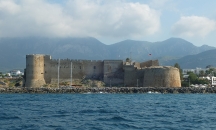No video yet
Kyrenia Castle
Kyrenia Castle (Greek: Κάστρο της Κερύνειας Turkish: Girne Kalesi), at the east end of the old harbour in Kyrenia is a 16th-century castle built by the Venetians over a previous Crusader fortification. Within its walls lies a twelfth-century chapel showing reused late Roman capitals, and the Shipwreck Museum.
History
Kyrenia has existed since the 10th century BC. Excavations have revealed Greek traces that date back to the 7th century BC, but the site was developed into a city under Roman rule.
Research carried out at the site suggests that the Byzantines built the original castle in the 7th Century to guard the city against the new Arab maritime threat. The first historical reference to the castle occurs in 1191, when King Richard I of England captured it on his way to the Third Crusade by defeating Isaac Comnenus, an upstart local governor who had proclaimed himself emperor.
After a short period, Richard sold the island to the Knights Templar, and then to his cousin Guy de Lusignan, the former king of Jerusalem. This began the 300 years of the Frankish Lusignan Kingdom of Cyprus (1192–1489). Initially the castle was quite small. John d'Ibelin enlarged it between 1208 and 1211. The Castle's main function was military and the improvements consisted of a new entrance, square and horseshoe-shaped towers, embrasures for archers, and dungeons.
The castle was subjected to several sieges. A Genoese attack in 1373 almost destroyed the castle, and the longest amongst the sieges, in the 15th century, lasted nearly four years and reduced the unfortunate occupants to eating mice and rats. By 1489 the Venetians had taken control of Cyprus and in 1540 they enlarged the castle, giving it its present-day appearance. The chief changes, such as the addition of thick walls and embrasures for cannons, were adaptations to changes in warfare in the form of gunpowder artillery. The Venetians also installed gun ports at three levels so that they could direct cannon fire against attackers from the land. Inside the castle, they built huge long ramps so as to be able to drag artillery up on the walls....






